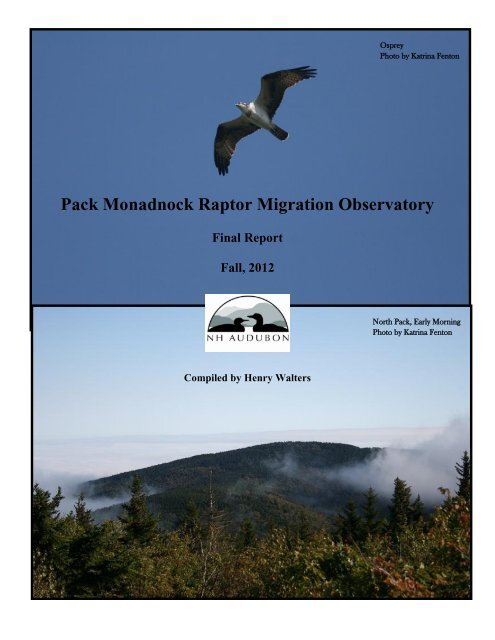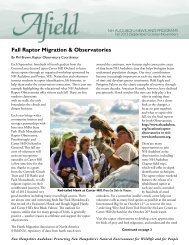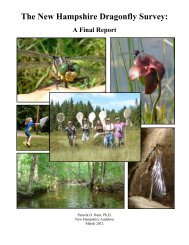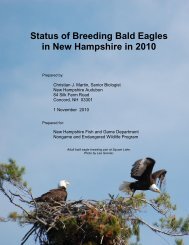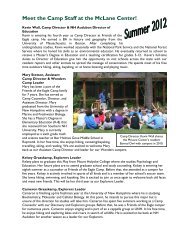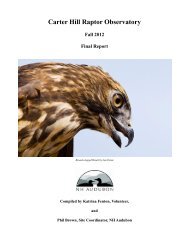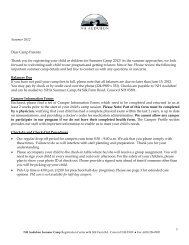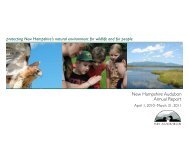2012 Annual Report - New Hampshire Audubon
2012 Annual Report - New Hampshire Audubon
2012 Annual Report - New Hampshire Audubon
- No tags were found...
You also want an ePaper? Increase the reach of your titles
YUMPU automatically turns print PDFs into web optimized ePapers that Google loves.
OspreyPhoto by Katrina FentonPack Monadnock Raptor Migration ObservatoryFinal <strong>Report</strong>Fall, <strong>2012</strong>North Pack, Early MorningPhoto by Katrina FentonCompiled by Henry Walters
The <strong>2012</strong> Season<strong>2012</strong> marked the eighth consecutive fall of full-time operation of the Pack Monadnock RaptorMigration Observatory, a season chock-full of old pleasures and fresh surprises, terrific efforts by ateam of experienced volunteers, and the arrival of many new, enthralled faces to the hawk-watchplatform. Most of all it was full of migrating birdsof prey: 12,038 of them, to be precise, all passingthrough southern <strong>New</strong> <strong>Hampshire</strong> betweenSeptember 1 st and October 31 st , the official countperiod, with another 286 migrants tallied in lateAugust and early November. The overall total isthe second-highest in the eight years of datacollection, and totals for every individual specieswere above average. What’s more, seven of thefourteen species of raptor regularly occurring atPack were seen in record numbers in <strong>2012</strong>,including the Osprey, Bald Eagle, and PeregrineFalcon. And as if that were not enough, two newspecies of raptor, Swainson’s Hawk and Rough-Legged Hawk, were recorded at the site for the firsttime. In all, 97 species of bird put in an appearancearound the observation platform this year, fromCape May Warblers in early September toBohemian Waxwings and Pine Grosbeaks in mid-November, not to mention the snakes, butterflies,insects, mammals (including a short-tailed weasel),Photo by Jo-Ann Matthewsmushrooms, ferns, and ever-shifting cloud formationsthat would transform the most single-minded hawk-watcher into a full-fledged naturalist. One canhardly imagine, on first arriving at this little granite outcrop at 2300 feet above sea-level, surroundedby thick red-spruce woods and open to the north wind, that the Pack Monadnock Observatory shouldso teem with life, but time and again the place reveals itself to be one of the crown jewels of southern<strong>New</strong> <strong>Hampshire</strong>.History and MissionThe Observatory was founded in 2005 by Iain MacLeod and has since been operated by <strong>New</strong><strong>Hampshire</strong> <strong>Audubon</strong> with a two primary purposes: to gather quantifiable information on raptormigration through the region, and also to serve as an educational classroom, both for students and thegeneral public, informing visitors about raptor biology, habitat, and the relationship between humansand birds of prey. Both goals are consistent with <strong>New</strong> <strong>Hampshire</strong> <strong>Audubon</strong>’s stated mission, “toprotect <strong>New</strong> <strong>Hampshire</strong>’s natural environment for wildlife and for people.”2
The long-term scientific goal of the project is to collect ten years’ worth of standardized data, whichwould allow for the undertaking of statistical analysis of raptor population trends. The site is one ofapproximately 169 consistently reporting North American watch sites, all of which enter their dailyobservations into a database administered by the Hawk Migration Association of North America(HMANA). Those numbers, for current and previous years, can be accessed by the public atwww.hawkcount.org.The full-time Counter/Naturalist for <strong>2012</strong> was Henry Walters, who staffed the site Wednesday throughSunday. Volunteers Iain MacLeod and Katrina Fenton acted as counters on Mondays and Tuesdays,respectively, the latter fresh off a spring season of hawk-watching at Bradbury Mountain, Maine.Together they logged 600.75 observation hours over 85 days, with 14 of those days returning zeroraptor data on account of bad weather or low visibility. Julie and Phil Brown acted as SiteCoordinators, overseeing operations, while their six-month-old daughter Laurel assisted in fundraisingefforts.Education and OutreachThe Pack Monadnock Observatory, located near the summit at the juncture of three hiking trails, andjust a few hundred yards from the parking lot, averages a few thousand visitors each year—not onlydyed-in-the-wool hawk-watchers, but hikers, tourists, day-trippers, trail-runners, leaf-peepers,motorcycle gangs looking to stretch their legs…all sorts of people, many of whom have never heard ofhawk-watching. This year over 3,100 people stopped to learn something about hawks at PackMonadnock. Thousands more, simply by walking by the observation platform, gained some exposureto the site. One of the great strengths of the Pack Observatory is the ease with which the general publiccan be introduced to the project and even begin to participate in it, right there on the spot. Educationabout birds of prey, their migration patterns, and the critical issues of environmental conservation thatwe face today, often starts with a glance at the “Daily Count” posted on a white-board and a simplequestion: “So you’ve really seen 100 Sharp-shinned Hawks today, eh?” Kurt Geerer, a fighter pilotfrom Pepperell, Massachusetts, out for a weekend jaunt this September, sat down at a picnic table nearthe observation platform and found the air overhead filled with pepper flakes: hundreds of BroadwingedHawks, kettling up in a thermal directly over the peak. By the time he left, having seen over athousand hawks, he was beaming, and repeating two phrases: “I had no idea. I’ve gotta come back. Ijust had no idea. Oh, I’ve gotta come back.” And indeed, he was back nearly every morning he had thechance.The site also serves as an important educational resource for many school groups from around the area.From elementary schools through college-level biology courses, dozens of teachers take advantage ofthis resource and bring their students to Pack Monadnock each year to witness part of the fallmigration. This fall, 655 students visited the site, from Peterborough, Dublin, Penacook, Harrisville,Hinsdale, and places even further afield. The Mass <strong>Audubon</strong> Young Birders Society made a trip to3
Pack, along with a group of teachers being trained in environmental education by Polly Pattison of theHarris Center in Hancock, <strong>New</strong> <strong>Hampshire</strong>. As state funding for schools is at a premium, teachers arehaving more and more difficulty finding the resources to bring students on a field trip, but suchinteractive, outdoor encounters are precisely the experiences that will inspire the next generation ofenvironmental stewards in our area and elsewhere.Word of the hawk-watch isspreading, and with it, its outreachpotential is growing. The site wasfeatured on a number of occasionsby The Monadnock Ledger, TheMonadnock Shopper <strong>New</strong>s, TheKeene Sentinel, The DublinAdvocate, The Hippo Press, andseveral other outlets. The annualhawk-release has become a majorcommunity event, drawing manyhundreds of spectators from thearea, plenty of them withyoungsters perched on theirshoulders. Held the second or thirdweekend in September, the eventPhoto by Lillian Stokescenters around the release of araptor back to the wild. Above, Henry Walters prepares to release this year’s bird, an immature broadwingedhawk nursed back to health by Maria Colby, director of the Wings of the Dawn rehabilitationclinic in Henniker. Other special events at Pack include the Big Sit, part of a nationwide bird censusheld in October, and the Big Soup, a celebratory year-end contest in which hawk-watchers bring ahomemade soup to the mountain in hopes of being crowned “Soup Champ.” After weeks of trashtalking,nine delicious, ornithologically titled soups were heated up on camp stoves this year, including“Creamy Merlin Medley,” “Caracara Carrot Cardamom,” and “Taiga Bean Goulash,” but only JulieBrown’s “Thai Chicken Hawk” took the prize, a one-of-a-kind, wool “Peregrine” hat knitted byKatrina Fenton.MethodsConsistency of observation methods is of great importance to the relevance of the data gleaned fromthe Pack Monadnock Observatory, and conscientious efforts are made to preserve it, both from day today and from year to year. The official counter is present and observing between 9 am and 5 pm, everyday between September 1 st and October 31 st , weather permitting. Scanning for birds is done with 8x or10x binoculars, while use of the spotting scope is generally limited to matters of identification. Effortsare made to scan all parts of the sky, above and below the horizon, even those areas that have beenempty most of the day. Observers maintain a conservative approach to the counting of raptors sighted,limiting the official count to “actively migrating” birds.4
Challenges to the consistency of these methods are worth noting. Some are partly within our control,such as preservation of the visible horizon where the growth of the spruce woods has begun toencroach upon it. Other factors, such as long-term changes in air quality—and consequently,visibility—may not be. (Hawk-watchers made the—albeit subjective—observation that <strong>2012</strong> had morethan its fair share of mornings of low-lying haze. Such trends may, however, be symptomatic of largerclimatic changes: this “ground level ozone” is more commonly in evidence on hot, dry, summerlikedays, of which we had many this fall, and may, according to projections, continue to have.)Ironically, one commonly raised question concerning the consistency of method in data-collection isalso one of the site’s confirmed successes: the steady increase in the number of dedicated,knowledgeable observers on the hawk-watch platform. While mid-September always brings a crowd,the entirety of <strong>2012</strong> was a team effort. The site effectively had two full-time observers, with KatrinaFenton volunteering at Pack an additional four days/week, in addition to her role as official countereach Tuesday. For the official count period, the average number of experienced observers on theplatform at any one time was between four and six, certainly up from the initial years of the study.(How many of us were balancing on the rocks back in 2006?) And even well into November, a numberof die-hard hawk-watchers continued to donate their time and expertise to the project. All of this wouldappear to result in an increase in the number of migrant raptors spotted and identified throughout theseason.But do more observers necessarily mean more birds? Numerous observers are needed to accuratelycount the hundreds of thousands of raptors seen at sites such as Corpus Christi, Texas, or Veracruz,Mexico; at Pack, however, the skies are not so full (with the exception of mid-September, perhaps) thata single counter cannot monitor the whole sky with reasonable success. This year’s average ratio of26.75 migrant raptors seen per observer hour logged does not set a terribly frenetic pace. And as anyhawk-watcher will attest, certain clear September days bring only a handful of hawks, regardless of thecrowd assembled on the platform. The overwhelming factor in spotting high numbers of birds is thepresence of birds in the roughly three-miles-wide airspace around the site. And their presence isdetermined by weather conditions, migration patterns, and population density. The number ofobservers, on the other hand, cannot be directly correlated with the number of birds seen. In otherwords, a large crew is wonderful, and valuable: birds are often spotted more quickly and enjoyed morethoroughly in passing; the educational outreach of the site is improved; indisputably more fun is had. Itdoes not, however, skew hawk-count data in any statistically significant way. If a visitor to Pack asksthe question, “How many observers should there be?” the people on the platform will invariably say,“The more the merrier!” And indeed, this is the true spirit of the project: the site was established, inpart, to promote the growth of interest in bird migration and in conservation biology more generally.Current levels of interest and participation in the hawk-watch should be sustained and, if possible,augmented. It can be done without compromising the value of the scientific work taking place here.5
Expanded Counting PeriodsJust over 600 hours of observation were logged in the fall of <strong>2012</strong>, well more than the yearly averageof roughly 430 hours. The reason for the discrepancy is the expansion of the count period on eitherside of the “regular season” into the last week of August and the first half of November. The purposeof this expansion was simply to gauge the level of migratory activity before and after the traditional(and somewhat calendrically arbitrary) boundaries of September 1 and October 31. But as the data forthese additional periods cannot be compared to previous years, it has been excepted from theconclusions that follow. All statistics in this report are based on data from the traditional countperiod of September 1-October 31. However, a few things can be learned from these “early” and “late”periods.As for August: 73.5 hours of data wascollected between August 23-31, with 97total migrant raptors counted. Similar datawas collected in 2010, between August24-31, when 143 raptors were counted.Based on these two years of data, thiscount period cannot be said to bestatistically significant for any of the 10species observed. That is, in no speciesdid August birds account for more than5% of the year-end species total. The oneexception was the American Kestrel: in2010, 15 kestrels were seen in August,accounting for 6.8% of the total of 221. In<strong>2012</strong>, only 8 kestrels were seen,accounting for 4.1% of the total of 194.“Socked In”Photo by Jo-Ann MatthewsOspreys, Bald Eagles, Sharp-shinned and Broad-winged Hawks also occur in small but steady numbersin August. However, even based on this extremely limited data set, one can reasonably predict thatAugust hawk migration at Pack will not be full of surprises, nor does the available data indicate thatfurther August counting is especially warranted. As one observer noted—after hours of boredom undera hot sun—“early September is slow enough as it is.” (Foot-traffic at Miller State Park, it is worthnoting, is higher in August—an advantage for educational outreach.)November, on the other hand, is a different story. Over 77.25 hours of observation in <strong>2012</strong>, 189migrants were counted—not in itself an impressive number, but a very important one. 138 of thosebirds were Red-tailed Hawks, accounting for 26.4% of the year-end total of 522 red-tails. This is thedifference between an average, even a below-average year for the species, and an exceptionally goodone. Any reasonable sample of a species’ migratory patterns should try to take into account a period inwhich a quarter of that sample passes the observatory. This year’s data is corroborated by previousNovember observations: 102 red-tails were counted in Nov. 2010, and 160 red-tails (in just 296
observation hours) were seen in Nov. 2006. The numbers are similarly telling for the Red-tail’s smallercousin, the Red-shouldered Hawk, and for two other important species: the Northern Goshawk and theGolden Eagle. Both are late-season migrants, and both occur in such small numbers that the usefulnessof count data depends on seeing as many of these birds as possible. 9 goshawks were seen inNovember, <strong>2012</strong>, 14.3% of the year-end total of 63. November of 2006 turned up 14 goshawks, 20.6%of the record total of 68. Data for the Golden Eagle tells the same story: 2 of this year’s 7 goldens wereseen in November; 3 of 9 in 2010; 5 of 11 in 2006. The importance of this species, which is not yetbreeding in <strong>New</strong> England, cannot be understated. If hawk-watches like Pack’s are an important tool inunderstanding this population and its migration tendencies, there is no question that the first half ofNovember is a crucial period in which to scan the skies for them.To conclude: while extending the count period into late August does not yield important statisticalresults, counting into the first half of November certainly does. Though data-collection during thisperiod has been spotty in previous years, <strong>2012</strong> should mark the start of consistent observation at thesite through November 15. With continued support from the wider community, Pack Monadnock willsurely continue to function as a hawk-watch well beyond its original ten-year charter (2005-2014), andthe additional data set for November—while not currently of great use—will gradually become moremeaningful. Furthermore, counting later in the season can help to answer one pressing but verydifficult question: will the long-term warming trends noted by climatologists have any noticeableeffect on the timing of bird migration? The warm weather of <strong>2012</strong>, and the correspondingly latemovement of ospreys, for instance, made this one of the most commonly asked questions at theObservatory. The additional resources needed to extend the count are significant, and arrangementswith Miller State Park, which closes for the season on October 31, must be made. But the mostimportant piece of the puzzle—the willingness of volunteers to man the site in sometimes (very) chillyweather—is already in place.The 10,000 th Bird of the Season: September 23Photo by Francie Von Mertens7
Species Accountswith charts by Julie BrownOsprey (Pandion haliaetus)<strong>2012</strong> Season Total: 307 [August: 7<strong>New</strong> Season Record2005-11 Average: 252 [Previous Record Highs: 291 (2007); 289 (2010)Single-day High: 36 (Oct. 6) [Single-day Record High: 75 (9/28/11)When a vicious-looking pile of black clouds made its move toward the Observatory one afternoon inSeptember, the couple hawk-watchers still remaining packed up their gear and skedaddled like shorebirdsbeneath a peregrine. A couple hundred yards down the mountain, the storm still hadn’t broken. Theystopped. “There’s going to be an osprey coming through,” muttered one to the other. They turned aroundand set up scopes again: sure enough, riding the front edge of the storm, slow and steady, a long-wingedfish-hawk, tucked up in its trademark “M.”Not only will the osprey fly in almost any weather, the height of its flight remains eerily consistent, aswell as the flight path the species chooses to take as it approaches the Wapack Ridge. Rarely does anosprey dart in and out of the vision; most are spotted well to the north, and can be relied upon to provideexcellent looks as they pass the Observatory. All these factors may, perhaps, make count-data for thisspecies more meaningful from year to year than for other species, whose flight patterns are more weatherdependent.Osprey movement this fall was noticeably protracted,with 133 migrants counted during October. By way ofillustration, total osprey numbers were comparable tothe 2006 and 2010 seasons, but the count for Octoberin each of those years was less than half of thatrecorded in October of this year. (Average count overthe previous seven Octobers: 45.) The 29 ospreyscounted in the last two weeks of October wereunprecedented—more than all ospreys counted in thesame period during the previous seven years combined. Furthermore, the peak period (defined here ashigh count over three-day interval) occurred between October 5-7, well over a week later than the average.(Sightings of lingering ospreys were widespread in many other corners of <strong>New</strong> <strong>Hampshire</strong> this fall, eveninto December in a couple NH locations.) Warm weather may have been an indirect factor in delaying thesouthward movement of ospreys, causing fish to feed closer to the surface, though the likely determinantwas probably the prolonged period of high pressure and southerly winds in October, as birds will oftenwait for the passage of a cold front and the helpful winds it brings.8
Bald Eagle (Haliaetus leucocephalus)<strong>2012</strong> Season Total: 97 [August: 5 [November: 3<strong>New</strong> Season Record2005-11 Average: 55 [Previous Record Highs: 80 (2010); 55 (2006)Single-day High: 14 (Sept. 12) [Single-day Record High: 15 (9/11/06)When visitors run their eyes over the “Daily Count,”they nearly always pause first at the same spot:“You’ve really seen a Bald Eagle today?” Indeed, aSeptember afternoon without a Bald Eagle was a rarityat Pack this season; the 97 birds seen (with another 8during extended count periods) is nowhere near theseven-year average of 55 birds, and 17 better thanPack’s previous high total of 80, set in 2010. Suddenspikes in a species count, like this one, are notthemselves indicative of year-to-year changes inpopulations, but this increase in eagle sightings certainly tallies with observations made all over theEastern half of the country in the past decade. Since eagle populations plummeted during the DDT era,they have rebounded strongly: 37 pairs of Bald Eagles are now known to nest in <strong>New</strong> <strong>Hampshire</strong>.(Compare this with the number of known nesting pairs in the state in 1988: zero.) Of the migrant eaglesthat could be definitively aged, 40.8% were full adults, 32.7% sub-adults, and 26.5% first-year birds,percentages that show a slight uptick in the relative numbers of mature eagles—a possible trend worthkeeping an eye on in years to come.Adult Bald Eagle (Parker River NWR)Photo by Jo-Ann Matthews9
Golden Eagle (Aquila chrysaetos)<strong>2012</strong> Season Total: 5 [November: 22005-11 Average: 7.0 (includes Nov. records) [Season Record High: 11 (2006)Single-day High: 2 (Oct. 25) [Single-day Record High: 3 (10/30/06, 11/3/06)The rarest of the annual visitors to the hawk-watch,and far and away the raptor most eagerly awaited bythe hardy October faithful, the Golden Eagle seems toinspire that mixture of awe and excitement usuallyreserved for pop stars or ancient ancestors risen fromthe grave. Part of the bird’s mythic aura comes fromits—possibly imagined—tendency to arrive duringperiods of extremity: if you are standing on theplatform experiencing extreme boredom, extremecold, or feel yourself under physical or emotionalduress, the next bird to appear will almost certainly be that jewel in the crown of any <strong>New</strong> England birder,a ridge-riding Golden Eagle. Its size, but also the peculiar ripple that runs through its long, hawk-likewing, the ease with which it makes progress even into a headwind, the sheen off its dark dark feathers…What exactly makes a golden beautiful is a matter of some debate, but nowhere is its beauty in question.One primary goal of the extended November count period was to help give a more complete picture ofGolden Eagle migration through the area. The species is a late-season migrant, with many birds thought topass in those weeks after the official count period has come to an end. From this perspective, Novemberwas a bit of a disappointment, with only 2 goldens spotted, and those in the first five days of the month.With warm weather and strong southerly flow persisting even into the middle of November, one mayspeculate that their migration was slightly delayed, but data from other watch sites does not support this.Pack’s average count of 7 birds a year is a very small sample;even the broadest conclusions about the species are difficult tosupport with our own available statistical evidence. Of theyear’s 7 goldens, 4 were first-year juveniles, 1 was immature,and 2 were full adults.Immature Golden EaglePhoto by John Terescik<strong>New</strong> research using satellite transmitters is beginning to yieldexciting new information about the eastern Golden Eaglepopulation. Migration seems to follow two main patterns: thebirds seen at Pack are likely originating in the Gaspépeninsula of Quebec, south of the St. Lawrence, while birdsfrom Labrador and Greenland—a far larger number—travelwest of us, through <strong>New</strong> York and Pennsylvania. (HawkMountain saw 172 goldens this fall, including 48 in a singleday!)10
Turkey Vulture (Cathartes aura)<strong>2012</strong> Season Total: 164<strong>New</strong> Season Record2005-11 Average: 91 [Previous Record Highs: 142 (2010); 120 (2006)Single-day High: 18 (Oct. 7) [Single-day Record High: 27 (10/16/09)If a few low, dark shadows put a slight chill in yourbackbone at the start of September, don’t panic—bythe end of the month, they will be long gone. Theusual squadron of Turkey Vultures around PackMonadnock in the early fall seems simply to meltaway by mid-October—a somewhat mysteriousdisappearance, given that relatively few vultures areseen actively migrating past the site. There is someevidence that the species prefers river valleys andhighways as “leading lines” on migration, which mayaccount in part for lower vulture numbers at Pack,whose main attraction is its ridgeline. Carter Hill Observatory to the north, located near the nexus of tworivers, provides an interesting comparison: many more migrant vultures are seen there annually, includinga Black Vulture in <strong>2012</strong>. Still, this year marked Pack’s high count for Turkey Vultures, at 164 birds, wellabove its seven-year average of 91. The trend for this species’ population in the region continues to pointupward.Northern Harrier (Circus cyaneus)<strong>2012</strong> Season Total: 87 [August: 2 [November: 22005-11 Average: 78 [Season Record High: 120 (2007); 112 (2010)Single-day High: 10 (Oct. 25) [Single-day Record High: 5,208 (9/18/11)As the last of the leaves fall and the landscape growspale in late October, the stage is set for the arrival of the“gray ghost”—the adult male Northern Harrier. Thelong, tapered, scything wings; the buoyant, slightlyseasick flight; the white rump patch visible for miles—all our harriers boast these, and each is a treat to see.But the silvery sheen of a male, seeming to collect allthe ambient light of an overcast day and emit it again,in condensed form, as he slides down the ridge-line,rocking unsteadily—this seems to belong to a differentkind of bird altogether, and may well take an onlooker’sbreath away until he is safely out of sight.11
The highest concentration of harriers occurred in the week-long period between October 20-26, in which36 of the season’s 87 migrants (41.4%) were spotted. These dates are somewhat later than similar“pushes” in past years, though the factors involved in migration timing are multiple and complex. Giventhat the harrier’s migration is drawn out over many months—some birds begin moving south in July;others will still be moving in December—hopes ran high for significant harrier numbers after the finish ofthe official count period. In light of that, the two harriers seen in November seem a remarkably lownumber. And by comparison with the elevated numbers of other raptor species seen this fall, the 87 totalharriers is none too impressive. The population of this bird in the East is shown to be holding steady orslightly declining, and relevant data from Pack will be important in fleshing out the larger picture in yearsto come.Adult Male Northern Harrier Photo by Jo-Ann Matthews — Juvenile Northern Harrier Photo by Katrina FentonRed-tailed Hawk (Buteo jamaciensis)<strong>2012</strong> Season Total: 378 [August: 6 [November: 138<strong>New</strong> Season Record2005-11 Average: 245 [Previous Record Highs: 361 (2009); 308 (2010)Tied Single-day Record: 53 (Oct. 24) [Previous Single-day Highs: 53 (10/27/06); 50 (10/31/10)Many a slow afternoon of hawk-watching may be whiled away studying the statuesque pose of a RedtailedHawk, stalled in mid-air, wings tucked, head down, with only a quick adjustment of a tail feather ortwo to balance against the shifting breeze. This behavior, called “kiting,” is effectively a kind of perchhuntingwithout a perch. One need not watch the display for many minutes before realizing the instinctiveprecision such behavior requires: not simply a friendly association with the wind, but a total harnessing ofit to suit the bird’s purposes. A red-tail perched along the verge of a highway or the edge of a farm fieldmay give the impression of a plump, sedentary, sluggish, rather complacent hawk, but given a glimpse ofit hunting for red squirrels over the spruce woods of Pack Monadnock, a birder begins to change his tune.12
Red-tails were everywhere in <strong>2012</strong>, with new recordsset for the September-October count period and anadditional 138 migrants tallied in November. (This“additional” push of birds is important to ourunderstanding of the species’ migration patterns andwarrants further study.) The peak migration periodoccurred in the six days from October 21-26, when180 migrants were counted. The timing of this peakperiod is in line with previous years.Rough-legged Hawk (Buteo lagopus)<strong>2012</strong> Season Total: 1<strong>New</strong> Site RecordMost migrant raptors are within sight for no more than a minute or so, and usually much less, but onehawk of October 23 rd stayed in Katrina Fenton’s vision for weeks, long after it had sunk below the sprucesto the west. Initially identifying the bird as a Golden Eagle, she remained puzzled by the odd proportionsof this large, dark, lanky bird, flying with a prominentdihedral. Much to her credit, her perseverance led to a reexaminationof a series of photos she had taken as the birddisappeared. Backlit, edge-on, going away, the bird was notin a terribly photogenic position, and yet certain thingscould be gleaned from the grainy image: by looking at thewidth of the body and length of the left wing, one gets asense of the bird’s proportions, which are manifestly thoseof a buteo rather than those of an eagle. Furthermore, byheightening the contrast between lighter and darker areason the underwing, one can see (at right) dark tips on theprimary feathers, with the rest of the primaries substantiallylighter, and a dark area encompassing the underwingRough-legged Hawk, 10/23/12photo by Katrina Fenton[contrast heightened]coverts, a plumage which would describe a dark-morph buteo—in the East, at this or any time of year, themost likely candidate is a Rough-legged Hawk, a dweller in tundra and taiga regions far to the north andone that migrates south in late fall or winter. The shape of the left wing, along with Katrina’s observationsat the time, are enough to confirm the bird’s identification as a Rough-legged Hawk, the first seen in thesite’s eight-year history. Kudos to Katrina, and thanks to a number of others, including Don and LillianStokes, whose collective sleuth-work resulted in the confirmation of this exciting record.13
Red-shouldered Hawk (Buteo lineatus)<strong>2012</strong> Season Total: 187 [November: 22<strong>New</strong> Season Record2005-11 Average: 64 [Previous Record Highs: 105 (2009); 89 (2007)<strong>New</strong> Single-day Record: 46 (Oct. 24) [Previous Single-day High: 45 (10/29/09)October 24 is rarely the most surprising day of thehawk-watch season, but this year it held a bonanza ofbuteos—not quite on the level of the September broadwingspectacle, but quite staggering in its own way.Groups of red-tails and red-shoulders, five and six at atime, came thermaling up and streaming off in thebroad-wing style, in a profusion hardly ever seen atPack. Both large hawks set daily highs, with 99 birds ofthe two species combined. Unseasonably warmconditions late in the month, complete with good thermal activity, may have given these migrants more liftthan usual and aided viewing conditions, but even so, this day was in a league of its own, and no oneexplanation seemed to satisfy. For red-shoulders in particular, an uptick in sightings was noticeablethroughout the fall, so that more than once hawk-watchers found themselves saying aloud, “Where are allthese birds coming from?” Last year the high daily count of red-shoulders was 11 birds; this year, doubledigits were reached on seven different occasions. As the species, with its transparent wing-crescents andhandsome plumage, often wins the popular vote in the catch-all category of “Most Beautiful Raptor,”many will be hoping for a repeat red-shoulder performance in 2013.Swainson’s Hawk (Buteo swainsonii)<strong>2012</strong> Season Total: 1<strong>New</strong> Site RecordConversation on the hawk-watch platform often turnsto speculation about what rarity might appear in theupcoming half-hour. All sorts of names are tossedaround: early in the year, Black Vulture, orMississippi Kite, and later on, as the weather getschilly and the wishful thinking gets wishier,Gyrfalcon, or Snowy Owl. Rarely, however, havethe words Swainson’s Hawk taken flight fromanyone’s lips, until the late afternoon ofSeptember 10, <strong>2012</strong>. A long-winged bird of slender proportions rose up circling over North Pack, a stiffwind dragging it slowly south-eastward. Though the late sunlight washed out many plumage details, thebird’s shape and style of flight were striking: very harrier-like in a soar—with pronounced dihedral andthin, tapered wings—and osprey-like in a glide—the wing pushed well forward at the wrist, with the14“Swainson’s Hawk Over North Pack”Pumpkin by Henry Walters Photo by Jo-Ann Matthews
“hand” thrown sharply backwards—but otherwise the bird’s proportions and plumage were unmistakablythose of a buteo, cousin to our familiar red-tails and broad-wings. Fortunately, this immature hawk gaveplenty of time for observers to put together the pieces of the identification puzzle: memories of Nebraskagrasslands clicked into place, and open-mouthed mystification turned into electrically charged butterfliesin the stomach: the site’s first record of this western species. Interestingly, an immature Swainson’s wasrecorded on the day following our sighting, at Chestnut Ridge in Bedford, <strong>New</strong> York, 140 miles southwestof Pack Monadnock—a reasonable distance for the bird to have traveled in 24 hours. Although the bird isan annual visitor to a number of eastern hawk-watches (25 Swainson’s have been recorded in the last tenyears in Cape May, <strong>New</strong> Jersey), it is rare in <strong>New</strong> <strong>Hampshire</strong>; the eastern vagrants, by and large, are birdsthat are trapped on the eastern side of the Great Lakes, getting funneled down through <strong>New</strong> York andPennsylvania. Most of these birds end their wayward migration in Florida, with a small population ofothers like them, while the vast majority of the species spends the winter on the pampas of Argentina.Broad-Winged Hawk (Buteo platypterus)<strong>2012</strong> Season Total: 8,821 [August: 272005-11 Average: 7,124[Season Record High: 11,831 (2011)Single-day High: 2,556 (Sept. 17)[Single-day Record High: 5,208 (9/18/11)One year ago, in 2011, an unprecedented wave of Broad-winged Hawks broke over Pack Monadnock—over 8,700 in just two days in mid-September. The airborne “stream” of hawks became a river, and then aflood. Afterwards, chiropractors all over southern <strong>New</strong> <strong>Hampshire</strong> were besieged with requests for neckmassage. In <strong>2012</strong>, while the broad-wing movement was also very strong, it occurred in a much lessconcentrated fashion. Days with the highest counts were September 12 (2,401 hawks), September 17(2,556), and September 20 (1,266). The timing of these “big days” is fairly consistent with previous years.(The trend, if anything, is one of very minor—perhaps irrelevant—delay of the migration. This is the firstyear in which a movement of 1,000 birds has happened as late as September 20.) Each push occurred twoor three days after the passage of a front, but weather on all three of those days was very clear, with highpressure, warm sun, and little wind. As a result of the calm conditions, birds seemed to pop up in almostany quadrant of the sky without sticking to any particular flight path. Some of the biggest streams of birdsappeared late in the day, directly out of the east, flying toward us, due west. The southeast is also acommon place to find kettles forming before noon, as the eastern side of the Wapack Ridge heats up in themorning sun and provides strong thermal lift. (Such patterns underscore the importance of preserving theview of the eastern and northeastern horizons, which are quickly being overtaken by the growth ofspruces.) Broad-wings are complete migrants, meaning that they vacate their breeding territory entirelyduring the winter months. While only a handful of broad-wings are left in the Northeast by the start ofOctober, this year an immature bird was seen on October 17, a very late record, though broad-wings havebeen observed at Pack as late as October 24 (2006).Broad-winged Hawks Kettling Over Pack15Photo by Katrina Fenton
Northern Goshawk (Accipiter gentilis)<strong>2012</strong> Season Total: 52 [November: 92005-11 Average: 34 [Season Record Highs: 59 (2010); 52 (2006)Single-day High: 7 (Sept. 27) [Single-day Record High: 8 (10/25/07)The goshawk seems to show up to the best effectwhen paired with other raptors: dwarfing a redshoulder,chasing a Cooper’s, climbing in a thermalbelow an eagle… <strong>2012</strong> was full of these comparisons,but no matter what species entered its orbit, all eyesstayed glued on the goshawk. That a bird of suchstunning size should also be able to juke throughdense woods with the sneaky quickness of apickpocket seems somehow unfair, as if aheavyweight boxer were also granted the ability toperform ballet. Pack Monadnock remains one of the prime hawk-watches in the East for viewing thissecretive bird in good numbers. This year was no exception, with good pushes of immature birds in lateSeptember and numerous point-blank looks at adults later in the fall. The migration peaks around thesecond or third week of October, though the September birds, including the 7 of Sept. 27, may represent asizable irruption of immature birds early in the year, a cyclical event noted in <strong>2012</strong> at other northernhawk-watch sites from Hawk Ridge, Minnesota, to Hawk Mountain, Pennsylvania. No early Septembersightings of goshawks at Pack, however, which might have indicated that a pair is nesting on or near PackMonadnock itself, as has been reported in previous years.Cooper’s Hawk (Accipiter cooperii)<strong>2012</strong> Season Total: 174 [August: 4 [November: 32005-11 Average: 147 [Season Record Highs: 206 (2006); 186 (2007)Single-day High: 13 (Oct. 5) [Single-day Record High: 21 (10/2/10); 16 (9/25/11)Like the other two hawks of the accipiter clan (the“true” hawks, as the genus is called in Europe), theCooper’s made a good showing in <strong>2012</strong>, finishingwell above its seven-year average. The species isthought to be on the increase in the eastern part ofNorth America. Like its smaller cousin the sharpshinned,it moves southward past Pack Monadnockthroughout the count period, with migration ofimmatures peaking in the second half of Septemberand the adults in mid-October. As a predator, itsspecialty is hunting birds in woodland areas, though its presence is increasingly noted in developed andeven urban areas, where it preys on pigeons, starlings, and—if you would believe the story of one veryearnest passerby—the occasional kitten. (No evidence was furnished of the criminal role the accused Coop16
played in the kitten’s disappearance.) Like the goshawk, it commonly chases prey into thick cover, evenpursuing its quarry on foot into brambles or underbrush if necessary. While no birds or kittens were lost toCooper’s Hawks on Pack this fall, so far as we can tell, and while the Cooper’s tends not to be as showilyaggressive toward other raptors on migration as the sharp-shinned, still, the bobbing head of our owldecoy can vouch for the fear this bird can inspire, should you ever chance to stare one down, beak to beak.Sharp-shinned Hawk (Accipiter striatus)<strong>2012</strong> Season Total: 1,349 [August: 31 [November: 8<strong>New</strong> Season Record2005-11 Average: 1,103 [Previous Record Highs: 1,280 (2007); 1,242 (2006)Single-day High: 111 (Oct. 8) [Single-day Record High: 122 (10/4/06)Sharp-shinned Hawk numbers have been remarkablyconsistent over the past six seasons at Pack, withtotals falling somewhere between 1,124-1,280 birdseach year, a variation of only 12.2%. The jump insharpies recorded in <strong>2012</strong>, then, represents a modestbut significant milestone, particularly for a specieswhose population is only holding steady, or slightlydecreasing, over much of the East. Because of theubiquity of this hawk in late September and earlyOctober (“There’s a sharpie over the rocks…anothertwo at Crotched…another sharpie behind us…”), having a number of observers helping to pick them out isimportant in registering a high count. This year, the crew of volunteers was more dedicated than ever, andtheir hard work was certainly a factor, though likely not the determinant one, in the new sharp-shin record.Migration of immature birds peaks in mid-September, with the migration of adults peaking in mid-October.Sharp-shinned Hawk—Photo by Jo-Ann Matthews17
Merlin (Falco columbarius)<strong>2012</strong> Season Total: 102 [August: 5 [November: 12005-11 Average: 71 [Season Record High: 138 (2010)Single-day High: 6 (Oct. 5, Oct. 21) [Single-day Record Highs: 13 (10/2/10); 12 (9/12/07)If you want to learn something about meteorites,you’ll have to do more than watch shooting stars. Asimilar problem presents itself when countingmerlins: the bird’s flight-path is not always enoughinformation to determine its intentions. In earlySeptember, when dragonflies are numerous in the airaround Pack, individual merlins will often stop for thenight on or near the peak. This year, one particularmale with especially vivid “eyebrow”-markings andconsistent feeding habits hung around the area for atleast four days. Unfortunately for data-collectors, amerlin that’s “hanging around” often behaves no differently from active migrants: both appear anddisappear in a flash at treetop level, if not below, zipping by southward without so much as a how-d’youdo…untilone pulls up sharply and perches on a dead snag, where he begins to preen his feathers andsurvey the peak like a landlord inspecting property. And so that old question—“How do you know you’renot counting the same bird twice?”—rears its head. While a male merlin rising up to the west may likelybe the same that plummeted there in a vertical stoop five minutes ago, what about this merlin to the east aminute later, coming in to harass the owl? A definite conservatism in counting merlins, plus an awarenessof their hour-to-hour and day-to-day activities around the peak, are necessary in order for count data onthis species to be meaningful from year to year.Beyond a doubt, <strong>2012</strong> was an excellent year for themerlins at Pack—the 102 birds recorded are secondonly to the 138 birds of 2010. Migration is spreadout more evenly across September and October thanfor any other raptor species, though slightly highernumbers occur in October. The merlin’s speed,aerial stunts, frequent attacks on the fake owl, andits tendency to perch on the snags around theObservatory, make this little falcon one of thecrowd-pleasing favorites.MerlinPhoto by Katrina Fenton18
Peregrine Falcon (Falco peregrinus)<strong>2012</strong> Season Total: 54<strong>New</strong> Season Record2005-11 Average: 32 [Previous Record Highs: 51 (2010); 44 (2007)<strong>New</strong> Single-day Record: 9 (Oct. 5) [Previous Single-day High: 7 (four times)One of the enduring images from the <strong>2012</strong> hawkwatchwas the slow-motion approach of an adultperegrine late in the day on October 1. How this bigfalcon makes any progress at all into a stiff southernheadwind, without so much as a twitch of the wings,is hard to fathom. After many minutes, just as she wasabout to disappear to the west of the Observatory, shegave a little wing-flick and fell out of the sky. Amoment later she rose up again, yipping like coyote:underneath her, a second adult peregrine, anotherfemale, the two rising up together like a pair ofshadows mimicking each other, perfectly synchronized. They raked across each other’s path, chatteringtheir displeasure, only to re-emerge a minute later, this time with a third bird, a sharp-shinned hawk divingout of their way with the panic of a rabbit bolting for cover. Sometimes a hawk-watcher begins to expectone marvel to yield another, and then another, in an unbroken chain.Peak time to see the peregrine comes in the first two weeks of October; in <strong>2012</strong>, 36 of the year’s 54 birds(66.7%) occurred between October 1 and October 15. Overall numbers of this species continue their slowbut steady increase. Two different subspecies of peregrine are seen at Pack: the tundrius, or “Tundra”peregrine, a breeder far to the north, which makes a vast migration southward from Alaska, northernCanada, or Greenland. Some tundrius winter as far south as the western coast of Chile, a trip of some9,000 miles. The other subspecies seen at Pack is the more rapidly increasing “Eastern” peregrine-—thehybrid race reintroduced to eastern North America after the bird was extirpated here. Birds of this“Eastern” type, many of which nest in urban areas, often make more limited movements southward,sometimes even staying on or near their breeding territory for the duration of the winter. Though“Eastern” peregrines show varying plumage characteristics, they tend to be much darker around the headthan tundrius, a difference often visible even at significant distances. Keeping track of relative numbers ofperegrine subspecies is another piece of the raptor migration puzzle that observers at Pack can help to fillin.19
American Kestrel (Falco sparverius)<strong>2012</strong> Season Total: 186 [August: 82005-11 Average: 159 [Season Record Highs: 206 (2010); 201 (2006)Single-day High: 15 (Oct. 8) [Single-day Record Highs: 32 (9/20/10); 30 (9/28/11)One thinks of the American Kestrel as a bird of openfields, subsisting on meadow voles and insects, athome on fenceposts and telephone wires, with adistant horizon laid out before him. How delightful,then, to watch a kestrel hunt the dense spruce woodsatop Pack Monadnock in early September. From treeto tree he went, as if he owned the place, the lateafternoonsun on him like a spotlight. The food thekestrel was seeking was a large green katydid livingin the upper stories of the spruces—he crashed inafter them with the reckless abandon of an accipiter, catching five or six in the course of twenty minutes,and eating them from an exposed perch fifty yards away. Through the spotting scope one could see theinsect’s discarded wings spinning down like maple seeds.The American Kestrel continues to be a species of some concern, as data from hawk-watches and breedingbird surveys show significant declines in its population, particularly in the East. <strong>2012</strong> was a good year forkestrel numbers at Pack, however, with above-average counts in both September and October. Kestrels aremoving even by the end of August, and continue through mid-October. Timing of the migration in <strong>2012</strong>was consistent with previous years; at Pack, there seem often to be two peak periods, the first comingsomewhere in the vicinity of September20-24, the second around October 6-10.Concentrated movements of kestrels arehighly weather-dependent; longstretches of clear, calm weather in <strong>2012</strong>meant that kestrel migration was moreevenly spread, with fewer “big days.”The documented declines have certainlyput the bird on the radar ofconservationists across the country; withtheir concerted efforts, we hope to seethese solid kestrel numbers at Pack formany years to come.American KestrelPhoto by Katrina Fenton20
Non-raptor MigrantsWhile Pack Monadnock was marked out as a prime spot to witness fall raptor migration, it also provesto be a whale of a good place for birding of all sorts. 97 species were recorded here between August 23and November 15—quite remarkable for what looks, at first glance, like a monoculture of spruce forestbarely hanging on to its granite substrate. But flocks of warblers descend here to feed in the morningsof early September, 18 species all told in <strong>2012</strong>, including Tennessee, Bay-breasted, and 9 discretesightings of Cape Mays. Vireos, kinglets, thrushes, and other passerines can be found in abundancethroughout the month of September. Yellow-bellied Flycatcher was a particular treat early in theseason.As the weather turns colder, swallows and swifts give way to flocks of migrating crows and waterfowl.Snow Buntings, American Pipits, Bohemian Waxwings, and a Northern Shrike made appearances, notto mention a panoply of winter finches, including Pine Siskin, Pine Grosbeak, Common Redpoll, andboth species of crossbill. November also brought an extremely late record of Tree Swallow.Below is a complete list of species recorded at Pack Monadnock this fall. They are listed along withthe date each was first seen and last seen, and the high daily count for the species. Data of particularinterest are highlighted in bold.Canada Goose (Branta canadensis) [Sept. 10-Nov. 15] (759, 10/13)Black Scoter (Melanitta nigra) [Oct. 12] (30)Common Merganser (Mergus merganser) [Sept. 9] (1)Red-breasted Merganser (Mergus serrator) [Nov. 5] (1)Common Loon (Gavia immer) [Sept. 10-Nov. 5] (7, 10/8)Double-crested Cormorant (Phalacrocorax auritus) [Aug. 26-Oct. 23] (65, 10/6)Great Blue Heron (Ardea herodias) [Sept. 11-Oct. 8] (2, 10/8)Semipalmated Plover (Charadrius semipalmatus) [Sept. 29] (1)Herring Gull (Larus argentatus) [Sept. 2-Nov. 15] (17, 11/3)Great Black-backed Gull (Larus marinus) [Sept. 3-Nov. 14] (1)Common Nighthawk (Chordeiles minor) [Sept. 16] (1)Chimney Swift (Chaetura pelagica) [Aug. 24-Sept. 14] (18, 8/25)Ruby-throated Hummingbird (Archilochus colubris) [Aug. 25-Oct. 5] (6, 8/26 & 8/31)Belted Kingfisher (Megaceryle alcyon) [Sept. 13] (1)Red-bellied Woodpecker (Melanerpes carolinus] [Aug. 28] (1)Yellow-bellied Sapsucker (Sphyrapicus varius] [Sept. 21-28] (1)Northern Flicker (Colaptes auratus) [Aug. 25-Oct. 13] (3, 9/27)Eastern Wood-Pewee (Contopus virens) [Aug. 26-Sept. 10] (1)Yellow-bellied Flycatcher (Empidonax flaviventris) [Aug. 24] (1)Northern Shrike (Lanius excubitor] [Nov. 12] (1)Blue-headed Vireo (Vireo solitarius) [Aug. 26-Sept. 17] (4, 9/9)Philadelphia Vireo (Vireo philadelphicus) [Sept. 6] (1)21
Red-eyed Vireo (Vireo olivaceus) [Aug. 24-Sept. 6] (3, 8/28)Blue Jay (Cyanocitta cristata) [Sept. 16-Oct. 15] (50, 10/9)American Crow (Corvus brachyrhynchos) [Oct. 11-Nov. 14] (225, 10/24)Red-breasted Nuthatch (Sitta canadensis) [Aug. 24-Nov. 2] (3, 10/5)Tree Swallow (Tachycineta bicolor) [Aug. 30-Nov. 11] (6, 9/15)Barn Swallow (Hirundo rustica) [Aug. 24-Sept. 5] (3, 8/24)Winter Wren (Troglodytes troglodytes) [Aug. 31-Oct. 21] (1)Golden-crowned Kinglet (Regulus satrapa) [Aug. 30-Nov. 12] (8, 10/7 & 10/15)Ruby-crowned Kinglet (Regulus calendula) [Sept. 24-Oct. 26] (4, 10/26)Eastern Bluebird (Sialia sialis) [Oct. 18-Nov. 5] (4, 10/15)Hermit Thrush (Catharus guttatus) [Oct. 18] (3)American Robin (Turdus migratorius) [Aug. 28-Nov. 5] (26, 11/5)European Starling (Sturnus vulgaris) [Aug. 28-Oct. 6] (1100, 8/28)American Pipit (Anthus rubescens) [Oct. 6-Oct. 21] (1)Bohemian Waxwing (Bombycilla garrulus) [Nov. 5] (3)Cedar Waxwing (Bombycilla cedrorum) [Aug. 24-Oct. 6] (6, 10/6)Snow Bunting (Plectrophenax nivalis) [Oct. 26-Nov. 15] (10, 11/15)Ovenbird (Seiurus aurocapilla) [Aug. 26-Sept. 21] (3, 8/26)Black-and-white Warbler (Mniotilta varia) [Aug. 24-Sept. 4] (1)Tennessee Warbler (Oreothlypis peregrina) [Aug. 25-Sept. 2] (2, 9/2)Nashville Warbler (Oreothlypis ruficapilla) [Aug. 25-Sept. 13] (3, 8/25 & 8/26)Common Yellowthroat (Geothlypis trichas) [Aug. 24-Sept. 12] (1)American Redstart (Setophaga ruticilla) [Aug. 24-Sept. 1] (2, 8/25)Cape May Warbler (Setophaga tigrina) [Aug. 24-Sept. 6] (3, 9/1)Northern Parula (Setophaga americana) [Sept. 3-Sept. 28] (1)Bay-breasted Warbler (Setophaga castanea) [Aug. 26] (1)Blackburnian Warbler (Setophaga fusca] [Aug. 25-Sept. 7] (2, three times)Yellow Warbler (Setophaga petechia] [Sept. 8] (1)Blackpoll Warbler (Setophaga striata) [Aug. 26-Oct. 12] (7, 8/26)Black-throated Blue Warbler (Setophaga caerulescens) [Aug. 24-Sept. 22] (2, 9/7 & 9/8)Palm Warbler (Setophaga palmarum) [Sept. 6-Oct. 20] (2, 10/8 & 10/15)Pine Warbler (Setophaga pinus) [Aug. 25-Sept. 14] (2, 10/25)Yellow-rumped Warbler (Setophaga coronata) [Aug. 30-Nov. 3] (200, 10/20)Prairie Warbler (Setophaga discolor) [Oct. 7] (1)Black-throated Green Warbler (Setophaga virens) [Aug. 25-Sept. 22] (6, 8/27)Chipping Sparrow (Spizella passerina) [Sept. 6-Sept. 7] (1)White-throated Sparrow (Zonotrichia albicollis) [Oct. 8-Nov. 1] (2, three times)Dark-eyed Junco (Junco hyemalis) [Aug. 23-Nov. 15] (10, 9/20)Scarlet Tanager (Piranga olivacea) [Aug. 24-Sept. 21] (6, 9/21)Red-winged Blackbird (Agelaius phoeniceus) [Oct. 17] (6)Pine Grosbeak (Pinicola enucleator) [Nov. 6-Nov. 14] (2, 11/14)Purple Finch (Haemorhous purpureus) [Sept. 15-Oct. 13] (7, 10/6)Red Crossbill (Loxia curvirostra) [Sept. 1-Nov. 15] (9, 11/12)22
White-winged Crossbill (Loxia leucoptera) [Sept. 7-Nov. 15] (30, 10/28)Common Redpoll (Acanthis flammea) [Nov. 14] (35)Pine Siskin (Spinus pinus) [Sept. 6-Nov. 15] (61, 10/17)American Goldfinch (Spinus tristis) [Aug. 26-Oct. 18] (18, 10/18)Evening Grosbeak (Coccothraustes vespertinus) [Oct. 13-Nov. 14] (7, 10/24)Non-migrant Sightings[Species given with date first seen and date last seen, and the high daily count for the species.]Ruffed Grouse (Bonasa umbellus) [Sept. 14] (1)Wild Turkey (Meleagris gallopavo) [Sept. 21] (3)Mourning Dove (Zenaida macroura) [Aug. 26-Sept. 28] (1)Barred Owl (Strix varia) [Sept. 11] (1)Downy Woodpecker (Picoides pubescens) [Oct. 7] (1)Hairy Woodpecker (Picoides villosus] [Sept. 16-Nov. 1] (1)Pileated Woodpecker (Dryocopus pileatus) [Sept. 9-Nov. 2] (2, 9/21)Common Raven (Corvus corax) [Aug. 24-Nov. 15] (43, 11/4)Black-capped Chickadee (Poecile atricapillus) [Aug. 23-Nov. 15] (20, 9/21)Tufted Titmouse (Baeolophus bicolor) [Oct. 12-Oct. 22] (1)White-breasted Nuthatch (Sitta carolinensis) [Aug. 31-Oct. 6] (2, 9/24)Immature Red-shouldered Hawk & Common RavenPhoto by Cliff Otto23
The Great Soup Contest (<strong>2012</strong> Champion: Julie Brown, for “Thai Chicken Hawk”)Photo by Jo-Ann MatthewsAcknowledgmentsWithout the support of a growing band of volunteers, the hawk-watch would not exist as we know it:you are at the very heart of this project. If standing together nose to nose with the north wind were notso much fun, who would keep coming back? You are almost too many to name—how lucky we arethat that is the case!—but we thank you for your time, energy, laughter, and delicious baked goods. Wewould be remiss not to acknowledge the exceptional company and commitment of Tom Delaney andAl Grimstad, both of whom spent a good deal of the fall squinting at distant specks through thespotting scope. And Katrina Fenton has practically grown up on this observation platform—thank youfor your untiring efforts and your love for the place.A special thanks to Alan Bostick, Rich Frechette and their trusty chainsaws for leading our pre-seasonclean-up operation around the Observatory. A great team of energetic sawyers, trimmers, haulers, andcheerleaders pitched in to make this annual “Work Day” a great success. The continued maintenanceof the northward view, given thoughtful management of the spruce habitat around the lookout, is notonly crucial to the consistency of hawk-count data but also preserves one of the area’s finest views ofthe Contoocook River Valley for thousands of visitors to the Park each year.24
Deep gratitude to Francie and Carl Von Mertens for hosting the hawk-counter in their own home,treating him like family and royalty at the same time. Francie’s unflagging activism, fundraising, andpublicizing on the part of the hawk-watch and countless other conservation causes make her a civicleader in the best sense.Thank you to Norma Rapuzzi and the wonderful staff at Miller State Park, who continue to support theproject in any way they can. Keeping the Park safe and open for visitors is difficult enough withouthaving to orchestrate a crowd of hundreds that descend one afternoon to watch the release of a hawkon top of your mountain. And hawk-watching, especially in September, often begins before and endsafter the Park’s scheduled hours—the permission to occupy the lookout for over two months isinvaluable. The success of our project is largely due to the understanding and cooperation of Miller’sgenerous staff.Thank you to the Jack Daniels’ Motor Inn for its continued support of the project, and to the manyprivate donors whose contributions allow the hawk-watch to survive from year to year. All of you whobought a t-shirt, a hat, a silhouette guide, or simply left a donation in the bluebird box—these gifts addup to a great deal.To Tom Baillio, Jami Bascom, David Baum, Alan Bostick, Meade Cadot, Jim Cahill, Glen Chretien,Anne Clauss, Patrick Curtin, Jerry Coffey, David Deifik, Janet Delaney, David & Sandy Fenton, JaneFiske, Miki Foley, Ira Gavrin, Mike Gebo, Kurt Geerer, Ginny & Jerry Gonville, Sharon & ScottHarvell, Jo-Ann Matthews & Tom Abbott, Nancy Moreau, Ken & Jeanne Navard, Cynthia Nichols,Steve & Kathy Olsen, Cliff Otto, Bill Preston, Ann Preston, David Ross, Don & Lillian Stokes, TracyTate, Carol Walsh, Tom Warren, Noel White, and many, many more, thank you all so much for youreyes, your irrepressible good spirits, and your contagious enthusiasm.And thank you, as always, to Iain MacLeod, Phil Brown, and Julie Brown, whose wisdom and hardwork have kept this whole wonderful thing going, and whose love for birds and the natural world arean inspiration to all they touch.Juvenile Broad-winged HawkPhoto by Katrina Fenton25
Clouds over North Pack, October 25, <strong>2012</strong>Photo by Glen Chretien~Here’s to a great year past, and a great year to come~~Thank you for all your support~26


